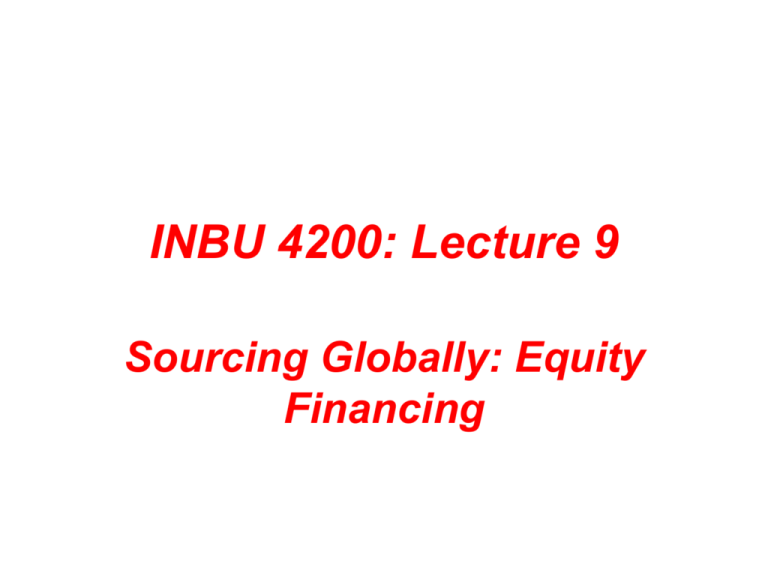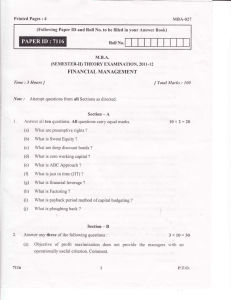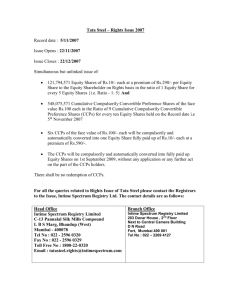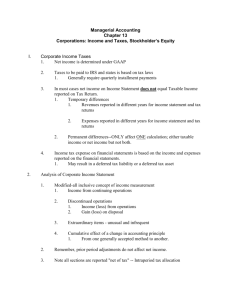Lecture 8
advertisement

INBU 4200: Lecture 9 Sourcing Globally: Equity Financing Objectives for Lecture 9 • Designing a strategy to source equity globally – Analyze the motivations and goals of a firm issuing new equity shares on foreign equity markets – Recognize the many barriers to penetrate effectively foreign equity markets through cross-listing and selling equity abroad – Identify the various financial instruments which can be used to source equity in the global equity markets – Review major stock exchanges outside of the United States: • London, Tokyo, Continental Europe (Frankfurt and Euronext) Strategy for Sourcing Equity Globally • Observations: – Most firms sources equity locally within their own domestic markets. • Most firms are unknown in global markets. – Move into international bond markets combined with cross listing of outstanding equity shares to gain recognition. – Test equity offering in smaller markets. – Eventually, list and offer in target equity market. • London Stock Exchange or NYSE Cross Listing of Shares • Definition: The listing of shares of stock on two or more stock exchanges. – Cross border in nature. • NYSE and London; NYSE and Tokyo! – There are fees involved. – There are disclosure requirements involved. • How can shares be listed? – Actual shares or depository receipts. Cross Listing on the TSE Foreign Listing Requirements in Japan • Minimum number of share to be listed – Depends upon average price (on home exchange). Varies from 20 million shares (average price less than ¥500) to 20,000 (average price ¥100,000 or more)! • Market capitalization of listed shares and time of incorporation of company – At least ¥2 billion; at least 3 years since incorporation. • Financial statements to be provided – Minimum 2 years, audited independently • Initial listing fees: – Examination fee: ¥1 million – Fixed fee: ¥2.5 million • Annual listing fee: – ¥0.0225 x number of shares listed (to a maximum of ¥13.5 million) Possible Reasons for Cross Listing • By cross-listing and selling its shares on a foreign stock exchange a firm typically tries to accomplish one or more of the following objectives: – Improve the liquidity of its existing shares and support a liquid secondary market for new equity issues in the foreign market. – Increase its share price by overcoming mispricing in a segmented and illiquid home market – Increase the firm’s visibility and political acceptance to its customers, suppliers, creditors & host governments – Establish a secondary market for shares used for acquisitions in foreign country – Create a secondary market for shares that can be used to compensate local management and employees in foreign subsidiaries Depository Receipts – Depositary receipts are negotiable certificates issued by a bank to represent the underlying shares of stock (which are held in trust at a foreign custodian bank) • Global Depositary Receipts (GDRs) – refers to certificates traded outside the US. • American Depositary Receipts (ADRs) – are certificates traded in the US. – ADRs are sold, registered, and transferred in the US in the same manner as any share of stock with each ADR representing some multiple of the underlying foreign share (called the ADR ratio). ADRs • An ADR is a dollar-denominated negotiable certificate that represents ownership of shares in a non-U.S. company. – The structure of an ADR includes a ratio, which correlates the amount of underlying shares to the receipt. – Ratio: the number of underlying shares represented by one American Depositary Receipt (ADR:Shares) – The ratio is typically depicted as, for example, 1:3, where one ADR represents three underlying shares. – Or, if the home share price is very high, for example, a 2:1 ratio would indicate two ADRs representing one underlying share (might also be expressed as 1:0.5). • ADR web site: http://www.adr.com/ Examples of ADRs (Japanese Companies, end of 2003) • Company Name • • • • • • • • • • • ALL NIPPON AIRWAYS BRIDGESTONE CORP1 : 2 CALPIS CO LTD CANON INC DAIWA SECURITIES FUJI PHOTO FILM CO LTD HONDA MOTOR CO LTD KIRIN BREWERY CO LTD KOMATSU LTD PIONEER CORP YAMAHA CORP • *Honda could also be expressed as 1:0.5 ADR:Share Ratio Sector 1:2 AIRLINES AUTO PARTS & EQUIPMENT 1 : 10 BEVERAGES 1:1 OFFICE EQUIPMENT 1 : 10 FINANCIAL SERVICES 1:1 MANUFACTURING 2 : 1* AUTO MANUFACTURERS 1:1 BEVERAGES 1:4 MACHINERY 1:1 ELECTRONICS 1:1 ELECTRONICS ADRs (October 2003) by Country • Country Number of Companies • Country Number of Companies • • • • • • • • • • • • • • • • • • • • • Sweden Venezuela Argentina France Turkey South Africa Brazil Norway Portugal Switzerland India Italy Russian Fed Japan Denmark Taiwan Netherlands Belgium Czech Republic Malaysia Thailand 7 Companies 2 Companies 10 Companies 23 Companies 1 Companies 6 Companies 33 Companies 5 Companies 3 Companies 11 Companies 6 Companies 12 Companies 19 Companies 29 Companies 3 Companies 3 Companies 27 Companies 1 Companies 1 Companies 2 Companies 1 Companies • • • • • • • • • • • • • • • • • • • • • United Kingdom Philippines Hungary Hong Kong Chile Finland Austria Spain Australia Peru New Zealand Ireland China Israel Germany Luxembourg Indonesia Singapore Greece Korea Mexico 62 Companies 5 Companies 4 Companies 14 Companies 15 Companies 4 Companies 3 Companies 7 Companies 12 Companies 2 Companies 1 Companies 6 Companies 5 Companies 6 Companies 24 Companies 1 Companies 2 Companies 4 Companies 3 Companies 5 Companies 18 Companies World’s Major Stock Exchanges • U.S. – NYSE – NASDAQ • London – London Stock Exchange (LSE) • Japan – Tokyo Stock Exchange (TSE) • Continental Europe – Frankfurt (Deutsche Borse) – Paris based Euronext London Stock Exchange • Founded in 1792. • Initially used by British Government to raise funds (war with France). • Big Bang in 1986: series of reforms liberalizing commissions and introducing a screen based trading system. Paved the way for foreign ownership. • Currently lists around 2,900 stocks, depository receipts, and bonds. Largest market in Europe! • As of Sept 30, 2003, 445 companies from over 60 countries are trading on the LSE (60 are U.S. companies). • Major stock index is the FTS 100 (largest 100 U.K. firms). • Official web site: http://www.londonstockexchange.coml FTSE 100 http://finance.yahoo.com/m2?u Examples of Foreign Listings on LSE • Company • • • • • • • • • • • Year Listed All Nippon Airways American Express Anheuser-Bush Bank of America Campbell Soup Daiwa Securities Euro Disney Ford Motor Co. General Electric Honda Motor Co. J.P. Morgan 1991 1977 1986 1996 1982 1990 1989 1966 1973 1981 1983 • Company • • • • • • • • • • • Year Listed Kirin Brewery Merrill Lynch Sara Lee Sony Corporation State Bank of India Tiger Brands Toshiba Toyota Motor1999 Vietnam Fund Xerox Zurich Financial 1990 1972 1981 1971 1996 1947 1980 2003 1972 2000 Frankfurt Stock Exchange • Traces its history to a long tradition of trading (bills of exchange and government bonds) back to the 1600s. • Lost its status as an international market during most of the 20th century as a result of World Wars; regained its international position in the mid-1950s. • The Frankfurt Deutsche Borse’s major stock index is the DAX (representing the 30 largest German firms). • Official web site: http://deutsche-boerse.com/ DAX Euronext • Euronext (Paris based holding company) formed in September 2000 by the merger of: – the Amsterdam and Brussels Exchanges and Paris Bourse. Added the Lisbon Exchange and London International Financial Futures Exchange (LIFFE) in 2002. • Has created a cross-border, electronic market for European and international equities and bonds. • Approximately 1,500 companies trade on Euronext. • Is currently Europe’s second largest exchange. • Euronext’s major stock index is the Euronext 100 (representing the 100 largest European companies). • Official web site: http://www.euronext.com/ Tokyo Stock Exchange • One of the oldest stock exchanges in Asia founded in 1878 (the oldest is the Bombay Stock Exchange founded in 1875). • There are four separate sections within the TSE market. – The first section is for the largest, most successful companies often referred to as 'blue chips'. – The second section is for smaller companies with lower trading volume levels. – Mothers (market for growth and emerging stocks), established in November 1999, is for newer, innovative venture enterprises. – The foreign section is for companies from countries other than Japan. • Official web site: http://www.tse.or.jp/ Tokyo Stock Exchange • Currently 2,147 companies are listed on the TSE (Oct 17, 2003): – – – – First Section: 1,525 Second Section: 560 Mothers: 62 Foreign: 32 • Major index is the TOPIX (TOkyo stock Price IndeX. all First Section listed shares) • The section for foreign stocks was opened in 1973 (when the TSE pushed to become an international exchange). By 1993, 120 foreign companies were listed on the TSE. However, through delisting since that time, 32 foreign companies remain. Of these 14 are from the US, and 7 are from Germany. – Why the delistings? • Japanese economy and Japanese stock market performance Japan: Economic Performance TOPIX Index (Jan 1986 = 100) http://www.tse.or.jp/EREALIDX/# U.S. Versus Japan U.S. Versus U.K. U.S. Versus Germany Methods of Sourcing Equity Funds • Alternative instruments to sourcing equity in global markets include the following: – Sale of a directed public share issue to investors in a target market – Sale of a Euro equity public issue to investors in more than one market, including both foreign and domestic markets – Private placements under SEC Rule 144A – Sale of shares to private equity funds Direct Public Share Issue • Directed Public Share Issues – Defined as one which is targeted at investors in a single country and underwritten in whole or in part by investment institutions from that country • Issue may or may not be denominated in the currency of the target market • The shares might or might not be cross-listed on a stock exchange in the target market • A foreign share issues, plus cross-listing can provide it with improved liquidity Euro Equity (Offshore) • Euro equity Public Issue – Gradual integration of worlds’ capital markets has spawned the emergence of a euro equity market – A firm can now issue equity (underwritten and distributed) in multiple foreign equity markets; sometimes simultaneously with distribution in the domestic market. Private Placement • Private Placement Under SEC Rule 144A – A private placement is the sale of a security to a small set of qualified institutional buyers – Investors are traditionally insurance companies and investment companies – Because shares are not registered for sale, investors typically follow “buy and hold” strategy – Rule 144A allows qualified institutional buyers (QIB) to trade privately placed securities without previous holding period restrictions and without requiring SEC registration Private Equity Funds • Private Equity Funds – Limited partnerships of institutional and wealthy individual investors that raise their capital in the most liquid capital markets – Then invest these funds in mature, familyowned firms located in emerging markets – Or purchase distressed firms in overseas markets. • Popular in Japan! • Long Term Credit Bank of Japan (1998)







